This lesson will cover the point-slope form of the equation of a straight line.
Consider a line which passes through the point (x1, y1), and makes an angle θ with the X-axis.

How can we find its equation? Let’s explore two different methods.
Method I
We’ll start with the slope-intercept form of the line. Let’s assume the equation to be y = mx + c (where m = tanθ).
Now, we do not know the value of c, but instead we know that the line passes through (x1, y1).
Recall that the equation of a line (or any curve in general) is a relation that holds true for every point on the line. Since the line passes through (x1, y1), the relation must hold true for this point as well.
Therefore, we can substitute these coordinates into the equation to get:
y1 = mx1 + c
On rearranging, this gives
c = y1 – mx1
We’ve got the value of c. Substituting this into the original equation, we’ll get the required equation as:
y = mx + y1 – mx1
The terms can be rearranged as follows:
y – y1 = m(x – x1)
And that’s the equation we were looking for – the point-slope form.
Method II
Here, we’ll derive the equation from scratch. Let’s take any point P(x, y) on the line.

Now, let’s construct a couple of line segments.

We constructed AQ parallel to the X-axis and PQ parallel to the Y-axis.
Now, in ΔAQP, we have:
tanθ = PQ/AQ
This means that:
tanθ = (y – y1)/(x – x1)
On rearranging the terms, we get
y – y1 = tanθ(x – x1)
⇒ y – y1 = m(x – x1)
Same equation as earlier.
Lesson Summary
- The equation of a line having a given slope m, and passing through a given point (x1, y1) is given by y – y1 = m(x – x1)
This form will be one of the most frequently used forms, so keep it handy. See you in the next lesson with some examples!